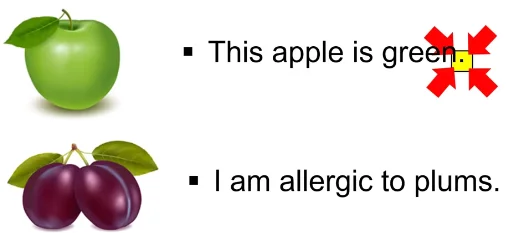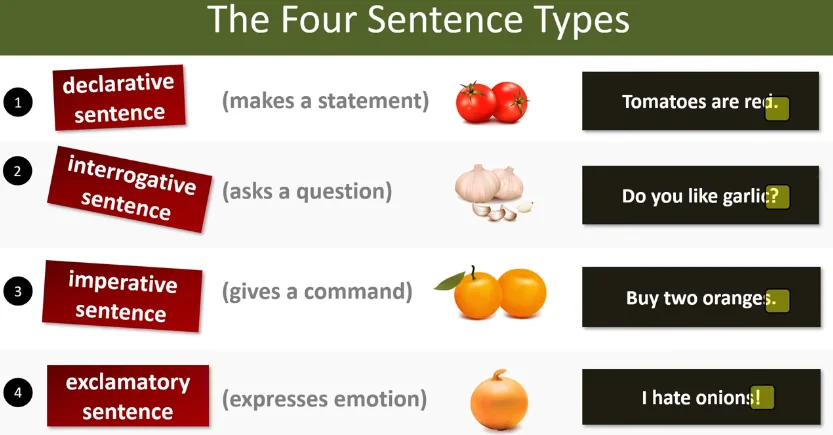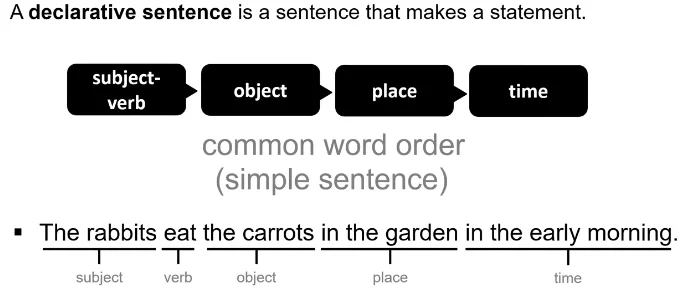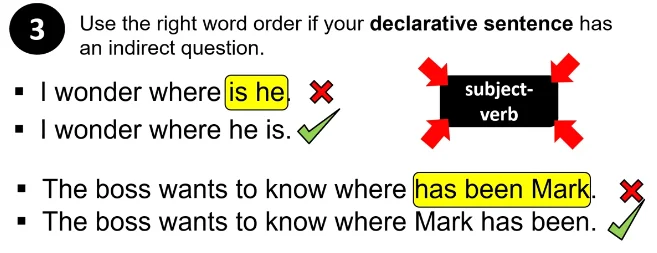Definition
A declarative sentence is what makes a statement or reports information about something. Here are easy examples.
Examples of Declarative Sentence
- This apple is green.
- The tomatoes are red.
- I am allergic to plums.
- This car runs very fast.
- Our neighbors are very kind.
- The baby is playing alone.
- The juggler shows tricks cleverly.
- The plane is flying high.
- Asia is the biggest continent in the orld.
- The crow is a clever bird.

These statements are examples of declarative sentences.
How do these sentences end? They end with a full stop or a period. They are among one of the four types of sentences given below. But there are other three types of sentences.
Comparison with other Types of sentences
- Interrogative Sentences
- Imperative Sentences
- Exclamatory Sentences

An interrogative sentence asks a question and ends with a question mark. For example:
- Do you like garlic?
- Where is your wallet?
- Did she buy a doll yesterday?
- What is your favorite hair style?
- Is the cost of vegetables going up?
- Are you fond of making a noise?
An imperative sentence gives a command or order to do something. For example:
- Go to the market now.
- Buy a bag of tea and coffee.
- Drink water with your right hand.
- Do not tease the kids at all!
- See me in the evening at the park.
An exclamatory sentence expresses emotion. Now, an exclamatory sentence and a declarative sentence look quite similar but it’s the punctuation at the end that makes them different.
- I hate onions!
- What a beautiful scenery!
- You are so cute.
- We have won the game!
- She lost the last straw!
It expresses the emotion and it ends in an exclamation mark. But we have a full stop for a declarative and imperative sentence. And we have a question mark for an interrogative sentence. But we have an exclamation mark for an exclamatory sentence.
Now, with an imperative sentence, it is possible for that to end in an exclamation mark as well if the command is forceful.
Word Order for a Declarative Sentence
- The rabbits eat the carrots in the garden in the early morning.
- Before the sun rises, the rabbits eat the carrots in the garden.
This is a simple sentence. Let’s start with the subject-verb pairing.

Here, is a common word order for a declarative sentence. So, this is a simple sentence that we have the subject, verb pairing and we have the object, the place, and the time as well. So, let’s analyze an example:
| Subject | Verb | Object | Place | Time |
| The rabbits | eat | the carrots | in the garden | in the early morning |
When you have a subject-verb pairing like that combined with full stops or periods in the end then you are looking at a declarative sentence.
3 Common mistakes with Declarative Sentences
Mistake of Comma
First, a common mistake: Do not end a declarative sentence with a comma.
Let’s see an example.
- Do not tease me I have a friend and companions, tease them.
- Do not tease me. I have a friend and companions who tease them.

“I have a friend and companions” that is a declarative sentence that should end at a full stop. That’s an imperative sentence, remember it’s an order. So, a comma looks like it might be okay here but actually, it’s not.
Another example:
Cannibals do not eat clowns, they taste funny.
Now, these are two declarative sentences and so they should look like two declarative sentences. This comma is wrong you cannot end a declarative sentence with a comma and then write another declarative sentence here. It’s called a run-on sentence.
Mistake of Question Mark
The second mistake that you see with declarative sentences: Do not use a question mark with a declarative sentence. For example:
- I wonder where he is?
- I wonder where he is.
That is not a question, where he is what is called an indirect question and an indirect question does not always feature in a question. “I wonder where he is”. It is a statement of a declarative sentence.
- The boss wants to know where Mark has been?
- The boss wants to know where Mark has been.

Again, it has the sense of a question but it’s not a question. It is a declarative sentence here is the correction with a full stop or a period in the end.
Mistake of word order (in Indirect Questions)
The third one is also related to indirect questions. Use the right word order if your declarative sentence has an indirect question.
So, let’s put the same examples up:
- I wonder where is he.
- I wonder where he is.

= “where is he” is the order, you would use for a question but this is an indirect question. And an indirect question has the same word order as a declarative sentence. So, this is wrong. Because it should be:
And, let’s go to our other example:
- The boss wants to know where has been Mark
- The boss wants to know where Mark has been.
So, with an indirect question if the whole sentence is a statement don’t put a question mark. And, use the word order for a declarative sentence.
Recap
Declarative sentences are sentences that make a statement and end in a full stop or a period with the word order of subject and a verb.
